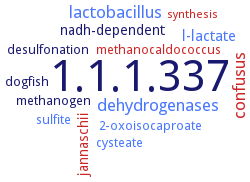1.1.1.337: L-2-hydroxycarboxylate dehydrogenase (NAD+)
This is an abbreviated version!
For detailed information about L-2-hydroxycarboxylate dehydrogenase (NAD+), go to the full flat file.

Word Map on EC 1.1.1.337 
-
1.1.1.337
-
lactobacillus
-
confusus
-
dehydrogenases
-
l-lactate
-
nadh-dependent
-
jannaschii
-
sulfite
-
2-oxoisocaproate
-
cysteate
-
desulfonation
-
dogfish
-
methanogen
-
methanocaldococcus
-
synthesis
- 1.1.1.337
- lactobacillus
- confusus
- dehydrogenases
- l-lactate
-
nadh-dependent
- jannaschii
- sulfite
- 2-oxoisocaproate
- cysteate
-
desulfonation
-
dogfish
-
methanogen
- methanocaldococcus
- synthesis
Reaction
Synonyms
(R)-sulfolactate dehydrogenase, ComC, L-2-hydroxyacid dehydrogenase, L-2-hydroxyacid dehydrogenase (NAD+), L-2-hydroxyisocaproate dehydrogenase, L-HicDH, L-hydroxyisocaproate dehydrogenase, L-sulfolactate dehydrogenase, MDH I, MJ1425, sulfolactate dehydrogenase
ECTree
Advanced search results
Crystallization
Crystallization on EC 1.1.1.337 - L-2-hydroxycarboxylate dehydrogenase (NAD+)
Please wait a moment until all data is loaded. This message will disappear when all data is loaded.
in complex with NADH, to 2.5 A resolution. The asymmetric unit contains a tetramer of tight dimers. Structure does not contain a cofactor-binding domain with Rossmann-fold topology. The NADH is bound in an extended conformation in each active site, in a manner that explains the pro-S specificity. Cofactor binding involves residues belonging to both subunits within the tight dimers. The results indicate the existence of a substrate discrimination mechanism, which involves electrostatic interactions
recombinant enzyme is crystallized with ammonium sulfate as precipitant in the presence of NAD+. The crystals belong to the trigonal space group P3(2)21, with a = 135.9 A and c = 205.9 A, and diffract X-rays to 2.2 A resolution


 results (
results ( results (
results ( top
top





